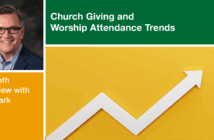This is the question raised by Martha Grace Reese and the Mainline Evangelism Project she directed. The results of her research, funded by the Lilly Endowment, Inc., were published recently in Unbinding the Gospel: Real Life Evangelism (Chalice Press, 2006). The purpose of the Mainline Evangelism Project was to see how well mainline churches were doing in helping people become Christians and to find examples of mainline churches doing effective jobs of evangelism.
For at least a century, mainline churches have tended to bring into their membership those raised in the denomination or those “brought to faith” in another tradition.
Reese begins by noting that the mainline Protestant decline is part of an overall decline in the Protestant presence in the United States. She cites research from the University of Chicago showing that America’s Protestant majority is fading rapidly and by now is probably no longer a majority. From 1972 until 1993, the percentage of Protestants in the U.S. remained stable at about 63 percent. However, by 2002 the number had dropped to 52 percent.
Reese discovered that mainline churches are doing very badly at helping people become Christians. This does not mean that persons are not joining these churches. But the vast majority of those joining mainline churches are new spouses or children of existing members. Furthermore, 65 to 80 percent of the fastest-growing congregations in these denominations are in the South or are predominantly racial/ethnic.
Thus, a logical question is whether it is possible today for primarily Caucasian congregations located outside the South to reach new believers with the Gospel in effective ways. Reese set out to find congregations that match this description. Unfortunately, there were not many to be found. Her analysis of thousands of congregations discovered that only one-half of one percent met the project’s criteria for effectively reaching adult new Christians not already connected with the faith or the congregation.
What was learned through this project?
- Both established and new congregations can reach new believers. Many of the effective evangelism churches had been around many years, showing that established churches as well as new congregations can reach new believers.
- Within the church, older and younger members had surprisingly similar attitudes. The real differences of opinion were not between young and old but between those who were raised in the church and those who were not.
- Most new Christians first attended church because they were invited. This study found that almost 60 percent of new Christians attended church the first time because someone invited them. While this confirms what many other studies have revealed, it seems few churches have applied this finding. New Christians said that the biggest barrier to attending the church was “not knowing anyone.”
- People connect with churches during times of life change. Whether the change is good or bad, people are most open to becoming involved with Christ and a church during seasons of change in their lives, such as marriage, divorce, or new parenthood.
- Visitors return because of the people and the pastor. “The people” is the factor cited by 38 percent of new Christians as the reason they returned a second time. The pastor is the second most frequently mentioned reason for returning.
- Decisions to join are motivated by a search for meaning in life. There is a change of focus when it comes to why new Christians decide to join the church. The friendships recede in importance for this decision. New members are particularly thinking about questions regarding the meaning of their lives, such as “What is missing in my life?” A lesson for churches here is that visitor follow-up plans need to build on fellowship and relationships but also move to give people opportunities to ask the big questions of meaning in their lives early in their time in the congregation.
- Faith decisions are deep and personal. New faith is personal. It is deep. Eternal life with God matters to new Christians. What do these conversions look like? It is hard for most church people to imagine. It is not about church; it is about Jesus. It is about one human being, at a crucial point in his or her life, learning about God being real in that life.
Practical suggestions for evangelism
Reese discusses “bandwidths of evangelism,” nine different kinds of people the church should attempt to reach, and “bridges into your church,” or passageways to build for new members. She also identifies “barriers to evangelism” – the things that block us from sharing the Gospel.
Reese sees several signs of hope for mainline evangelism. First, mainline pastors and laypeople are beginning to acknowledge openly that they are not doing a good job with evangelism; and it actually bothers them. Second, some of the old liberal/conservative/charismatic polarizations are beginning to shift and melt. And finally, after decades of decline in the development of new churches, some denominations have placed an emphasis on church planting.
For at least a century, mainline churches have tended to bring into their membership those raised in the denomination or those “brought to faith” in another tradition who, for various reasons, later joined a mainline church. Neither strategy addresses the call to bring new persons to Christ. It is now time to remember that the mainline churches were the original evangelical churches in America.






